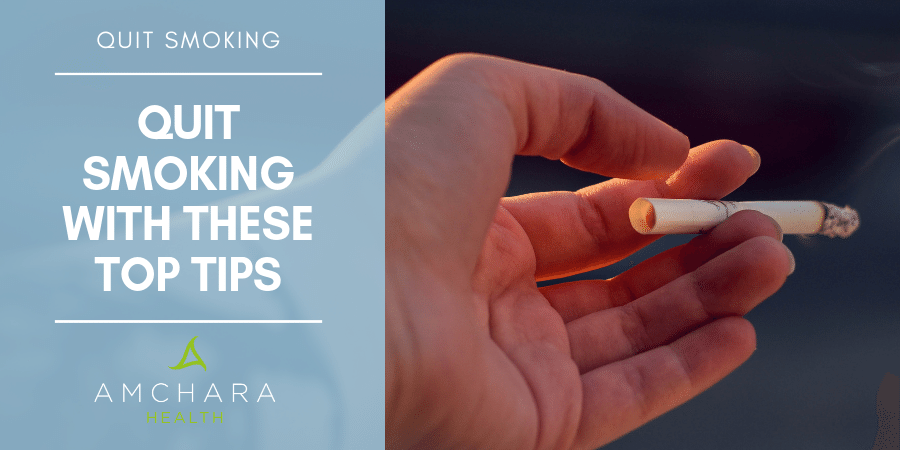Topics Covered in this article:
The decision has been made – quit smoking.
That’s the easy part!
Quitting any habit is difficult and certainly a learning curve.
There are many health benefits to quitting smoking and a variety of different ways of going about it.
We always take an evidence-based approach to provide you with actionable knowledge and tips to help you on your journey to optimal health – in this article we discuss our top recommendations to successfully quit smoking.
Quitting
There is no easy way to quit smoking. The longer the habit, the harder it may be.
The key is to make a commitment to quitting and find ways of dealing with the cravings and after effects of quitting.
Many people turn to food to feed their addiction when they quit smoking and ex-smokers may find they put on weight as a result.
This is simply replacing one bad habit with another unhealthy bad habit.
Positive changes give positive results – for the long term.
Supporting yourself through the process can mean making several changes and incorporating new activities or habits.
The Transition
Going cold turkey isn’t always the best solution for everyone.
It can bring about strong sugar cravings, irritability, mood swings and headaches.
A period of time using patches, up to three weeks maximum, may be of help.
Patches can be reduced over those weeks to gradually reduce the body’s exposure to nicotine.
If you prefer to call it quits and avoid nicotine entirely then it will help if you are prepared for the effects.
They can last up to three weeks but once you are past this you will feel significantly better.
Top Tips:
#1. Be Specific
Make a list of the reasons why you want to stop and put the list in several visible places.
Every time you see the list you will be reminded of why you are making the changes.
Visualise yourself as a non-smoker – ask yourself how would you look?
How would you feel?
How would those around you feel?
What would you gain?
If one of your reasons is financial, what will you do with the money you are saving?
Visualise yourself enjoying your healthier lifestyle and spending the extra cash.
Never underestimate the power of the mind. Successful sports people use positive visualisation to see themselves winning; this has the effect of making the mind believe they will actually win and increases the chance of success.
#2. Avoid Taking up Other Bad Habits
Keep active and busy. Take time to think about what you really like to spend time doing and fill your time with activities you enjoy,
You could try a new activity – taking up a new hobby such as painting, crochet, knitting, scrapbooking, photography or starting a family history can all keep you focused on positive things, rather than thinking about smoking.
Take yourself away from environments where you would have previously had a cigarette, this may mean avoiding the pub for a while.
Prime your friends who are smokers – let them know what you are planning and ask them to help by not smoking around you.
#3. Deal with Cravings
Cravings often come in the form of a sudden need for something sweet.
This can be a niggling urge or an overwhelming desire to reach for chocolate, sweets or biscuits. Keeping a healthy blood sugar balance is vital.
When blood sugar is low the body send out signals to crave substances that will raise the blood sugar levels.
This can exacerbate cravings for cigarettes.
When energy is released evenly from food throughout the day you are less likely to reach for a cigarette (or sweet treat).
In order to create a steady, even release of energy throughout the day it is recommended to:
- Eat little and often and avoid skipping meals.
- Eat protein with each meal or snack – this helps to fill you up and slows the release of energy from food.
- Reduce alcohol and caffeine – these are stimulants like cigarettes and impact blood sugar and stress hormones.
- Avoid added sugars and be wary of natural sugar alternatives – they still impact blood sugar negatively.
- Include lots of fresh fruits and vegetables – with an emphasis on vegetables. Aim for 8-10 portions a day.
- Include fibre – this keeps you fuller for longer and prevents hunger cravings. Choose whole grains over refined white goods and include oats, lentils, beans, nuts and seeds.
- Consider supplementing with N-acetylcysteine and glutamine – these support healthy neurotransmitter balance, cravings and aid in detoxification (1,2).
#4. Support Toxin Clearance
Smoking introduces many toxic chemicals into the body and once you stop smoking these can be released.
This can lead to symptoms including headaches, brain fog, nausea, aches and pains and feeling like you are ‘coming down with something’.
This is the last thing you need when quitting smoking and it can really hamper enthusiasm and motivation for reaching the end goal – being cigarette free.
Food and nutrients are vital to support the body in mobilising, detoxifying and eliminating toxins.
Key steps to take include:
- Increase vitamin C and vitamin E rich foods – citrus fruits, broccoli, peppers, tomato, avocado, oily fish, olive oil and nuts and seeds.
- Increase liver supportive foods – cauliflower, kale, garlic, watercress, coriander, lemon, grapefruit, turmeric, beetroot, dark berries.
- Drink plenty of water – at least 2 litres a day.
- Keep up fibre intake – to sweep the bowels and encourage elimination. Oats, brown rice, lentils, beans and nuts are good choices.
- Consider a green powder – wheatgrass, spirulina, chlorella and barley grass can be very cleansing for the body and are easily added to a smoothie.
#5. Make Positive Lifestyle Changes
Regularly incorporating new positive habits helps you to stay motivated, improve health and wellbeing.
Some suggestions include:
- Incorporate meditation and mindfulness – there is a higher chance of success in people who learn and partake in regular mindfulness and meditation (3). Meditation has been shown to reduce stress, anxiety and depression (4). Mindfulness has been shown to help with addictions (5).
- Breathing exercises – techniques to support controlled breathing have been shown to reduce stress (6). Quitting smoking puts the body, and mind, under significant stress. Learning how to step away from the shallow breathing that occurs during stress can increase oxygen supply to the body and relieve tension.
- Exercise – aerobic activity (the kind of activity that makes you sweaty and breathless) reduces the urge to smoke. Withdrawal symptoms and cravings decrease during exercise and can last for up to 50 minutes afterwards. Exercise is known to aid release of endorphins – feel good chemicals. Aim to exercise 3 times a week for at least 30 minutes duration. This can be jogging, power walking, swimming, cycling, rollerblading – anything that raises your heart rate. Being active every day is important not only when quitting smoking but also for long term cardiovascular and mental health.
This doesn’t need to be the end of the article.
With your help let’s continue the conversation.
Did you find this article useful?
Do you have any other top tips for quitting smoking?
Please share your thoughts and help others.
READ THIS NEXT:




